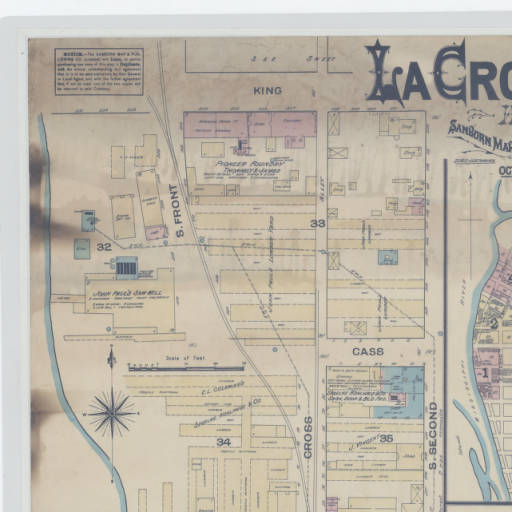Businesses & Industries
Resources
—Lumbering—
Description:
Sanborn Fire Insurance maps are meticulously detailed, large-scale lithographed, color-keyed street maps. Sanborn Maps helped insurance agents in the late 19th and early 20th centuries determine the degree of fire hazard associated with a particular property. Sanborn Fire Insurance maps typically focus on the business districts within communities. Features include street names, street and sidewalk widths, property boundaries, locations of fire hydrants, locations of water and gas mains, and the names of most public buildings, churches and companies. The maps also document the strength of the local fire department and the presence of fire hazards such as blacksmith forges, large baker's ovens or stored kerosene, and the existence of firefighting equipment, cisterns or community water works. Rivers, canals, railroad corridors and similar features are also noted. Each map provides a detailed assessment of the buildings within a district. Assessments include an outline of each building and outbuilding, the size and number of stories of every building, the location of windows and doors, fire walls, and indications of sprinkler systems. They note the nature of the business or businesses which occupied individual buildings, sometimes even particular room uses. They list the type of construction and the composition of building materials including the framing, flooring, and roofing materials.
Author:
L. G. Sorden
Creator:
Sorden, L. G. (Leland George)
Description:
The lumberjack had a language all his own. This logging "dictionary" is an attempt to preserve the terminology of the lumberjack in the early days of logging in the Lake States. - Forward
Isabel J. Ebert is a co-author
Isabel J. Ebert is a co-author
Author:
Thesis (M.A.) -- University of Wisconsin-Madison
Creator:
Casberg, Selma Sather
Creator:
Johnson, Dorothy Sagen
Description:
In the last half of the nineteenth century, the area of West Central Wisconsin became synonymous with logging and the lumber industry. As the forests of this region were being exploited to their fullest, men and women poured into the regions along the rivers which served as highways to the pineries. One of the main centers of activity was an area which encompassed the point at which the Black River joins the Mississippi. At this point, settlers established two rival settlements within two years of each other. One of the cities, La Crosse, became famous as a lumber town; the other, Onalaska, became a "boom town", but never was able to rival her competitor in population or economic growth. The story of La Crosse and her lumbering history has often been related in papers and theses, but the history of Onalaska has been only half told in various civic directories, short newspaper articles, and centennial brochures. Since local history has long fascinated me, and since I am now a resident of Onalaska, I decided to explore Onalaska's early history as a subject for my seminar paper. It soon became evident that Onalaska history was also going to be a history of lumbering on the Black River, since that industry was the reason Onalaska was established. The purpose of this paper, then, is to recount briefly the history of lumbering along the lower Black River, and to describe its effect upon Onalaska from 1852 through 1902. By reading old newspapers, city and county records, and various printed materials concerning the subject and area in question, I believe that I have been able to compile a paper which is both interesting and informative, and academically acceptable as a research project.
UW-L Seminar Paper
UW-L Seminar Paper
Map showing the location of sawmills at Onalaska, North La Crosse and La Crosse, Wisconsin,1850-1910
Description:
Shows the location and gives names of the sawmills along the Black River and Mississippi River from Onalaska to La Crosse between the years 1850 to 1910.
Map / 2 maps 51 x 41 cm / Black and white.
Map / 2 maps 51 x 41 cm / Black and white.
Author:
University of Wisconsin-La Crosse Oral History Program
Description:
Geneva Ragland discusses her family history and social life and customs in early La Crosse history. Topics include but are not limited to: log riding, Ho-Chunk community members in 1870, baseball, Hixon family and home, Gillette family, Johns family, horse racing, and teaching and education.
Tape 2
Author:
University of Wisconsin-La Crosse Oral History Program
Description:
John P. Gilbertson begins his interview by discussing his Norwegian family history. His interview largely focuses on La Crosse social life and recreation, as well as his career as a letter carrier. Topics include but are not limited to: saw mills, railroads, Coon Valley, family working-class occupations, the Great Depression, history of the La Crosse Post Office, steamboats, La Crosse Inter-State Fair, farm technology, newspaper and press industry, education in La Crosse, Wisconsin Business University, the circus, segregation from Ho-Chunk community and community racism, Bartl Brewery, anti-Black racism and interracial marriage, river and lumber industries, Goosetown, gambling houses and City policies, anti-German discrimination, WWI, automobiles, federal government, development of the La Crosse Normal School (now UW-L), Hoeschler family, medical history, Adolf Gundersen, early Ho-Chunk community members, early Black American community members, La Crosse Historical Society, Nathan Myrick, local politics, Wisconsin Progressive Movement, corruption in La Crosse Police Department, personal sentiments towards communities with different identities than his own (Indigenous, Black American, and Jewish).
Note: This interview has sections of poor audio quality.
Tape 2
Tape 3
Tape 4
Note: This interview has sections of poor audio quality.
Tape 2
Tape 3
Tape 4
Creator:
Munson, Drucilla Kathleen
Description:
Gideon Cooley Hixon (1826-1892) was an influential businessman in the settlement and development of early La Crosse, Wisconsin. Although a capitalist and investor, the trade he is most remembered for is as a lumber baron.
UW-L Seminar Paper
UW-L Seminar Paper
